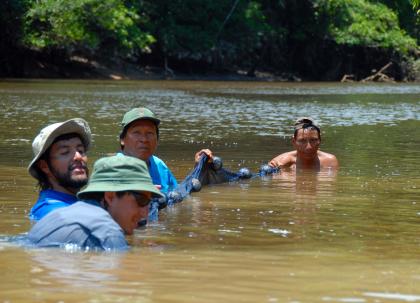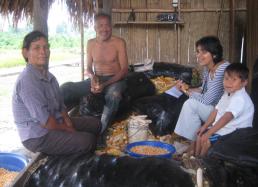2. What's a Rapid Inventory?
To kick off my journal entry, I thought it might be best to record exactly what’s involved in a Rapid Inventory, and then jump into our first few days. First of all, our inventories include a biological and social component. I'll be writing about the biological team’s trip, but we'll include video journals from the social team as well.
During the Rapid Biological Inventory, our team of geologists, botanists, ichthyologists (see above photo), herpetologists, ornithologists, and mammalogists doesn’t attempt to produce an exhaustive list of species. Rather, we work to (1) characterize a site (What habitats are present? Which species are common? Which species are rare?) and (2) determine whether this site is outstanding in a regional or global context.
During the Rapid Social Inventories, scientists and local communities collaborate to identify patterns of social organization and natural resource use and management. By participating in daily life and through semi-structured interviews, the team identifies strengths of these communities that can serve as points of engagement for long-term stewardship of the area (see Photo #1 below.)
Then we bring together the biological and social results of the inventory to paint a broad-brush sketch of the area, highlighting its biodiversity and the conservation vision of local residents. In-country scientists are central to the field teams. After the inventories, protection of natural communities and engagement of social networks rely on initiatives from host-country scientists and conservationists.
Once these Rapid Inventories have been completed (typically within a month), the teams relay the survey information to local and international decision makers who set priorities and guide conservation action in the host country. But more about that later…
As I mentioned, this is our first truly bi-national inventory, and the logistics are super complicated. We're going into the field in Ecuador, crossing the border at the intersection of Ecuador, Peru, and Colombia, and then leaving through Peru! Making this work has taken a super-human effort, and our logistics guru, Alvaro del Campo, has really spearheaded this effort (see Photo #2 below.) To learn more about what it takes to coordinate such a large-scale inventory, take a look at Alvaro’s “Video Report 3: Planning and Camp Life,” or check out his amusing “Video Journal 3: Camp Nightlife.”
Most of the U.S.-based team (Debby, Robin, Doug, and I) flew to Lima on October 2nd, and met with Peruvian officials on October 3rd to iron out the last few details with our research permits. That afternoon we hopped on a flight to Quito, and from there we met up with the rest of our Peruvian and Ecuadorian team.
Many of these scientists have been on previous trips with us, and it is great to see everyone again. Mainly we talk about the other trips we’ve taken since we were all last together, and the conservation progress in the areas where we worked last. All of this happens in Spanish, our official language for the inventory (although the social team will conduct some of the inventory with Secoya, Kichwa, and Huitoto interpreters). And to be honest, Doug Stotz, our ornithologist, speaks something that resembles “portuñol,” a combination of Portuguese and Spanish that reflects his many years studying birds in Brazil.
On October 4th, we all flew to Lago Agrio and spent an hour or so waiting for officials to stamp our passports to show that we were “leaving” Ecuador. We won’t actually leave until October 21st, but we're going where there are no immigration officials! That same afternoon, we took large canoes down the Aguarico River for about five-and-a-half hours until we reached the Cofan community of Zabalo (see Photo #3 below.)
Here we met up with old friends, including Randy Borman, a long-term collaborator and the recipient of the Parker-Gentry award in 1998. It was fantastic to get out of the city, and we all camped out on the soccer field. Tinamus (ground-dwelling birds shaped like footballs) were singing as we went to bed, and we woke up to a spectacular dawn chorus of birds and insects.
More to come tomorrow…
Corine
Written October 4, 2007




